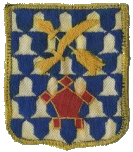1ST INFANTRY DIVISION
FOR THE PERIOD 12 SEPTEMBER 1944 - 30 SEPTEMBER 1944


12 September 1944
The regiment moved from the vicinity of Herve and, with Company C, 16th Infantry, leading, the outer defenses of the Siegfried Line were cracked, and the 16th Infantry, 1st U. S. Infantry Division, was the first Infantry unit to enter Germany. Enemy opposition was severe and casualties were sustained In the Aachen State Forest when pillboxes and antitank defenses were encountered.
13 September 1944
Regiment in the process of moving to objectives in the vicinity Aachen with the 3rd Battalion meeting very stiff resistance, four miles south of Aachen. A counterattack, with extremely heavy artillery support, was sustained by the 1st Battalion, with heavy casualties resulting.
14 September 1944
The regiment continued to move on to objectives south of Aachen and met stiff resistance from main Siegfried defenses. Heavy casualties were sustained. Numerous obstacles were breached, and another counterattack was repulsed.
15 September 1944
One reinforced company from the 1st and one from the 2nd Battalion attacked and moved to objectives south of Munsterbush. After seizing the objectives, the remainder of the 1st and 2nd Battalions moved on to objectives. The 3rd Battalion moved to its objectives and the regiment set up an all-around defensive position.
16 September 1944
Company A moved into position to assist the 3rd Armored Division to seize and hold their objective, Munsterbush. The remainder of the regiment improved defensive positions. The 1st Battalion was engaged in hand to hand combat with enemy forces.
17 September 1944
The 1st and 2nd Battalions were counterattacked at daylight and, with combined efforts of air and artillery, the counterattacking force was driven off. The enemy suffered severe casualties in this encounter. Company A attacked to the east and seized limited objectives. No ground was lost by the regiment.
18 September 1944
Companies A and B pushed forward against strong enemy resistance to seize and hold limited objectives. Company G, holding the highest and most important ground in the regimental zone, beat off a small, but furious, enemy counterattack. All units were engaged in active patrolling in an effort to learn the enemy's intentions. Enemy artillery fire during the period was fairly heavy. Casualties were severe.
19 September 1944
Regiment in position to resist enemy counterattacks. The 3rd Battalion, 18th Infantry, was attached to CT 16 as a reserve battalion. The 1st Battalion was in position to assist the 3rd Armored Division in seizing and holding their positions. All battalions engaged in active patrolling. Enemy artillery was active during the period.
20 September 1944
The 1st Battalion was given the objective of clearing Stolberg of all enemy forces. Companies A and C were held up slightly in their advance due to very strong enemy resistance on their fronts. The Company B advance was very slow because of stubborn resistance. The enemy was using fortified houses in the B Company zone to delay the advance. The 2nd and 3rd Battalions consolidated their positions, and the 2nd Battalion encountered strong enemy patrols. Company L, 18th Infantry, was committed on the right rear of Company B, 16th Infantry, to aid in the advance.

